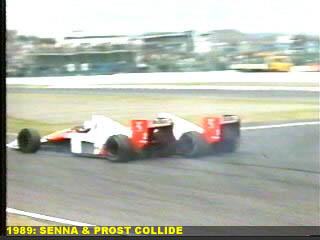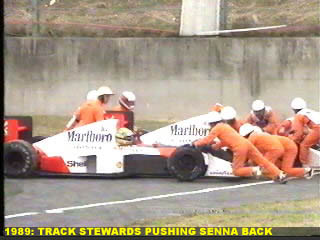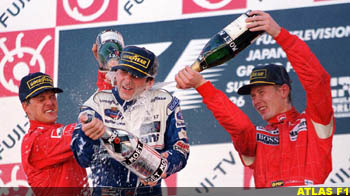|
The history of the Japanese Grand Prix is a relatively short one, but also one which has brought us many unforgettable moments. From the first race in 1976 until this year's championship finale, both Suzuka and Mount Fuji always played an important role in the Formula One Championship battle.
Two drivers immediately spring to mind when thinking of the Japanese Grand Prix: Ayrton Senna and Alain Prost. The archrivals of the late 80's made Suzuka the stage of the fiercest of their many battles. It began in 1988 where, after a season of close and fierce battle between the two, Senna claimed his first world title. A superb drive in drenched conditions awarded Senna of victory and the title.
 In both 1989 and 1990 this resulted in dramatic collisions between the both of them. The first time, they were teammates at McLaren and collided seven laps from the end of the race while battling for the race lead. Prost was leading the race when Senna dove inside at the chicane before the start-finish straight. When the Frenchman refused to move aside and Senna also kept his line, the cars collided. Prost's race was immediately over, but the Brazilian made it to the pits for a new nose cone. In both 1989 and 1990 this resulted in dramatic collisions between the both of them. The first time, they were teammates at McLaren and collided seven laps from the end of the race while battling for the race lead. Prost was leading the race when Senna dove inside at the chicane before the start-finish straight. When the Frenchman refused to move aside and Senna also kept his line, the cars collided. Prost's race was immediately over, but the Brazilian made it to the pits for a new nose cone.
 Alessandro Nannini put his Benetton briefly in the lead, but he was defeated by Senna when the finish flag dropped. However, after the race Nannini was presented the win, while Senna was disqualified for getting a push-start from the track marshals, along with a six months suspended race ban and a $100,000 fine. This resulted in a long lasting controversy between the Brazilian and the French FISA president Jean-Marie Balestre, who had been the one who took Senna's win away and with that the chances for winning the title. In fact, Senna even threatened quitting Formula One altogether at that time and while he never fulfilled that threat, two years later, when Senna won his third title, he openly accused Balestre of stealing his title in 1989. Alessandro Nannini put his Benetton briefly in the lead, but he was defeated by Senna when the finish flag dropped. However, after the race Nannini was presented the win, while Senna was disqualified for getting a push-start from the track marshals, along with a six months suspended race ban and a $100,000 fine. This resulted in a long lasting controversy between the Brazilian and the French FISA president Jean-Marie Balestre, who had been the one who took Senna's win away and with that the chances for winning the title. In fact, Senna even threatened quitting Formula One altogether at that time and while he never fulfilled that threat, two years later, when Senna won his third title, he openly accused Balestre of stealing his title in 1989.
 In 1990, the rivalry between the precise Frenchman and the temperamental Brazilian once again saw a clash of cars at Suzuka. This time, the circumstances were a little different than the year before. The giants ran into each other at the start of the race and neither of them was able to continue, giving Senna the title and his revenge. Overshadowed by this classic start line shunt, it was again a Benetton driver who took the victory: Nelson Piquet and Roberto Moreno scored a great one-two. In 1990, the rivalry between the precise Frenchman and the temperamental Brazilian once again saw a clash of cars at Suzuka. This time, the circumstances were a little different than the year before. The giants ran into each other at the start of the race and neither of them was able to continue, giving Senna the title and his revenge. Overshadowed by this classic start line shunt, it was again a Benetton driver who took the victory: Nelson Piquet and Roberto Moreno scored a great one-two.
Apart from these two dramatic events, Ayrton Senna always showed extraordinary class in the Japanese Grand Prix. He led five of the seven races he started, won two and never actually finished a race less than second. With his two wins, Senna ranks equal to Michael Schumacher, Damon Hill and Gerhard Berger, but only after slowing down to let McLaren teammate Berger take the win in 1991.
After Senna waved Berger into the lead in 1991, the trend was followed by Nigel Mansell the year after, handing Williams teammate Riccardo Patrese the win in Japan. Sadly for the Briton, right after this action his engine blew up. In 1993 Ayrton Senna yet again caused a major controversy at Suzuka. After having won the race, he argued with rookie Eddie Irvine, who scored a great sixth place for Jordan. Senna, demanding perfection from everyone, felt the Ulsterman had blocked him during the race. Eventually Senna got into trouble by punching Irvine.
However, Japan is not only the story of Senna's success, but also McLaren's. Of the fourteen Japanese Grands Prix, the British team led in no less than eleven races.
This began at the very first race, then held at the Mount Fuji track. In absolutely horrifying weather circumstances, James Hunt secured his championship title with a third place, after Ferrari's Niki Lauda, who had just returned from his terrible accident at Nurburgring, retired (along with five other drivers) because of the weather.
The year after, Hunt won at a sunny Mount Fuji, giving McLaren the first of its four victories in the Japanese Grand Prix. However, his win was overshadowed by the death of two spectators who were hit by Gilles Villeneuve's car, after the Ferrari was launched over the barrier off Ronnie Peterson's Tyrrell. After two races, this also meant the end of Mount Fuji's Formula One events.
Ten years later, Honda was a successful engine supplier and they brought Formula One back to Japan at the track they owned since 1963: Suzuka. The track quickly became one of the most loved tracks of Formula One.
 After the Senna and Prost era, another two titans battled it out at Japan: in the last four years, Suzuka has been the domain of Michael Schumacher and Damon Hill. The Briton took home the win twice in his Williams days, while the German gave both Benetton and Ferrari a victory in the land of the rising sun. Much like Senna, Schumacher finished first, second or not at all. After the Senna and Prost era, another two titans battled it out at Japan: in the last four years, Suzuka has been the domain of Michael Schumacher and Damon Hill. The Briton took home the win twice in his Williams days, while the German gave both Benetton and Ferrari a victory in the land of the rising sun. Much like Senna, Schumacher finished first, second or not at all.
Of these battles, 1994 stands out as the most exciting. In heavy rain, Schumacher and Hill served up a brilliant battle with a tactical edge. In the end Schumacher was just short of the win even though he was rapidly closing in on the Briton in the final stages of the race.
However, the year after Schumacher ended up on top, scoring his ninth win of the year and giving Benetton its first constructors championship. Between the Benettons of Schumacher and Herbert, a little McLaren success was noted: Mika Hakkinen scored a second place for the British team. With his second of three podium finishes so far, the Finn proved that Suzuka is one of his best circuits.
What happened last year:
- Jacques Villeneuve (Williams) set pole in 1:36.071s, with Michael Schumacher's Ferrari second in 1:36.133s.
- Villeneuve raced under suspension and finished fifth but was later disqualified from the results after losing his appeal against a yellow flag penalty during practice.
- Michael Schumacher won the race and opened a gap of one point over Villeneuve in the WC.
- Heinz Harald Frentzen (Williams) set the fastest race lap in 1:38.942s. He finished second.
- Eddie Irvine made an impressive overtaking maneuver, passing both Villeneuve and Schumacher in one go. He led the race for 25 laps, then letting Schumacher by. Irvine finished third, having lost a position to Frentzen at the second pit stops round.
- Both Benettons went for three stops, both Stewarts for one. All others used a two stop strategy
- Qualifying was red flagged five minutes before the end after Gianni Morbidelli crashes hard. Because of a hand injury, he was unable to start the race
|

 5.
5. In both 1989 and 1990 this resulted in dramatic collisions between the both of them. The first time, they were teammates at McLaren and collided seven laps from the end of the race while battling for the race lead. Prost was leading the race when Senna dove inside at the chicane before the start-finish straight. When the Frenchman refused to move aside and Senna also kept his line, the cars collided. Prost's race was immediately over, but the Brazilian made it to the pits for a new nose cone.
In both 1989 and 1990 this resulted in dramatic collisions between the both of them. The first time, they were teammates at McLaren and collided seven laps from the end of the race while battling for the race lead. Prost was leading the race when Senna dove inside at the chicane before the start-finish straight. When the Frenchman refused to move aside and Senna also kept his line, the cars collided. Prost's race was immediately over, but the Brazilian made it to the pits for a new nose cone.
 Alessandro Nannini put his Benetton briefly in the lead, but he was defeated by Senna when the finish flag dropped. However, after the race Nannini was presented the win, while Senna was disqualified for getting a push-start from the track marshals, along with a six months suspended race ban and a $100,000 fine. This resulted in a long lasting controversy between the Brazilian and the French FISA president Jean-Marie Balestre, who had been the one who took Senna's win away and with that the chances for winning the title. In fact, Senna even threatened quitting Formula One altogether at that time and while he never fulfilled that threat, two years later, when Senna won his third title, he openly accused Balestre of stealing his title in 1989.
Alessandro Nannini put his Benetton briefly in the lead, but he was defeated by Senna when the finish flag dropped. However, after the race Nannini was presented the win, while Senna was disqualified for getting a push-start from the track marshals, along with a six months suspended race ban and a $100,000 fine. This resulted in a long lasting controversy between the Brazilian and the French FISA president Jean-Marie Balestre, who had been the one who took Senna's win away and with that the chances for winning the title. In fact, Senna even threatened quitting Formula One altogether at that time and while he never fulfilled that threat, two years later, when Senna won his third title, he openly accused Balestre of stealing his title in 1989.
 In 1990, the rivalry between the precise Frenchman and the temperamental Brazilian once again saw a clash of cars at Suzuka. This time, the circumstances were a little different than the year before. The giants ran into each other at the start of the race and neither of them was able to continue, giving Senna the title and his revenge. Overshadowed by this classic start line shunt, it was again a Benetton driver who took the victory: Nelson Piquet and Roberto Moreno scored a great one-two.
In 1990, the rivalry between the precise Frenchman and the temperamental Brazilian once again saw a clash of cars at Suzuka. This time, the circumstances were a little different than the year before. The giants ran into each other at the start of the race and neither of them was able to continue, giving Senna the title and his revenge. Overshadowed by this classic start line shunt, it was again a Benetton driver who took the victory: Nelson Piquet and Roberto Moreno scored a great one-two.
